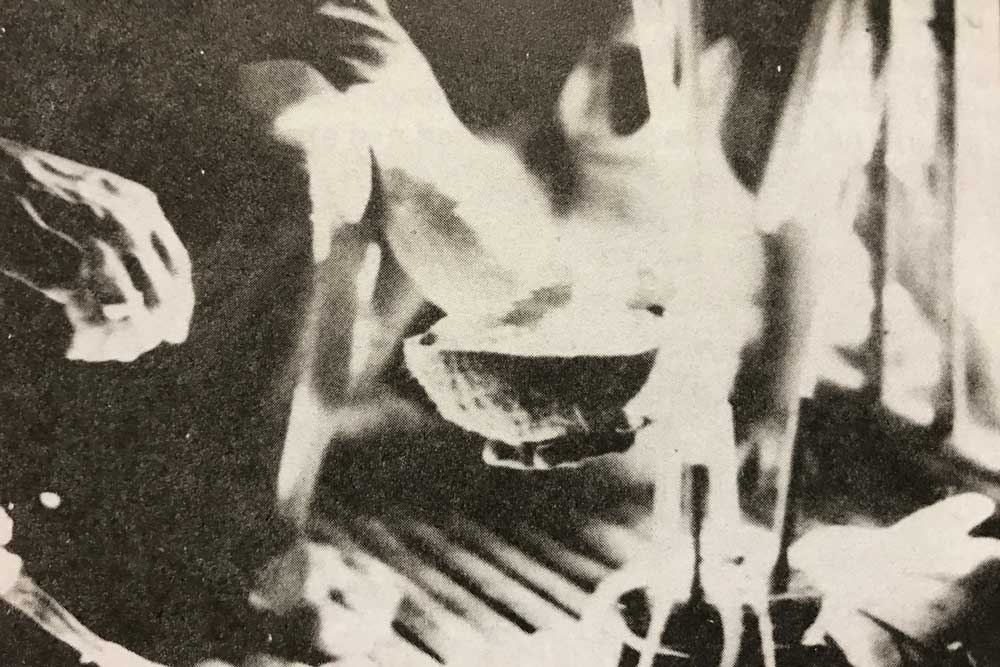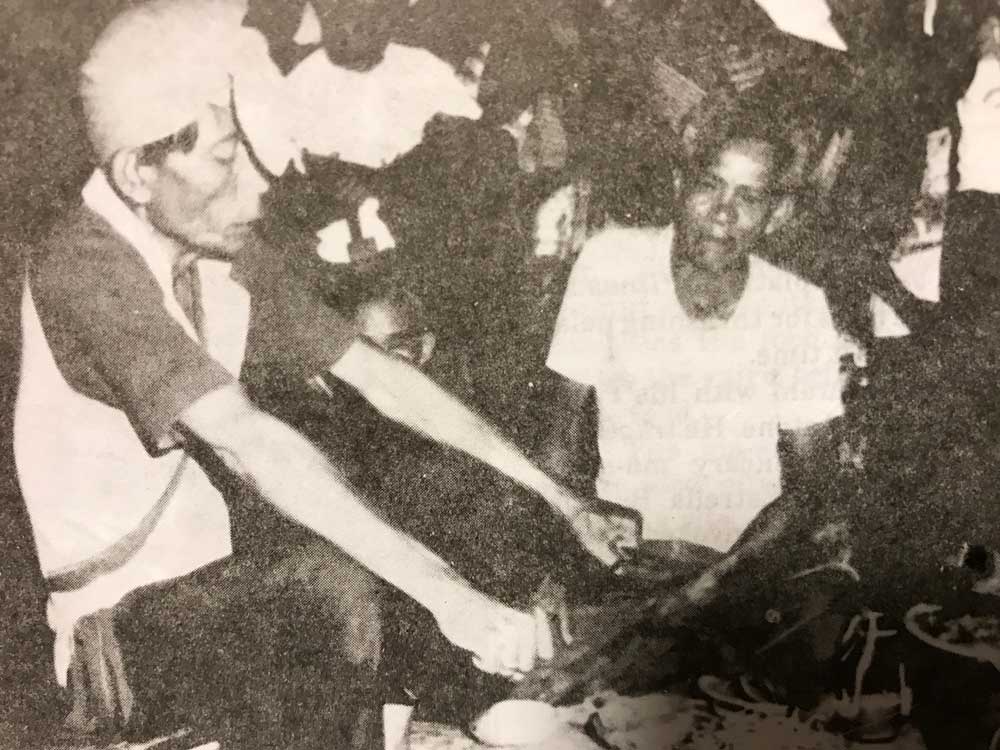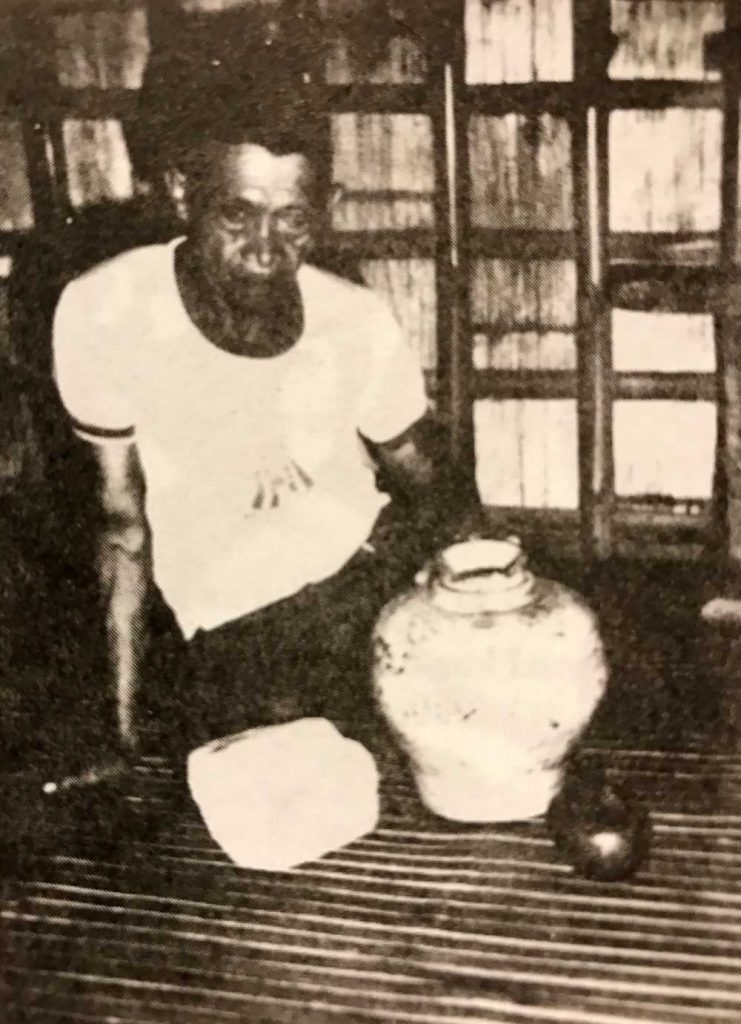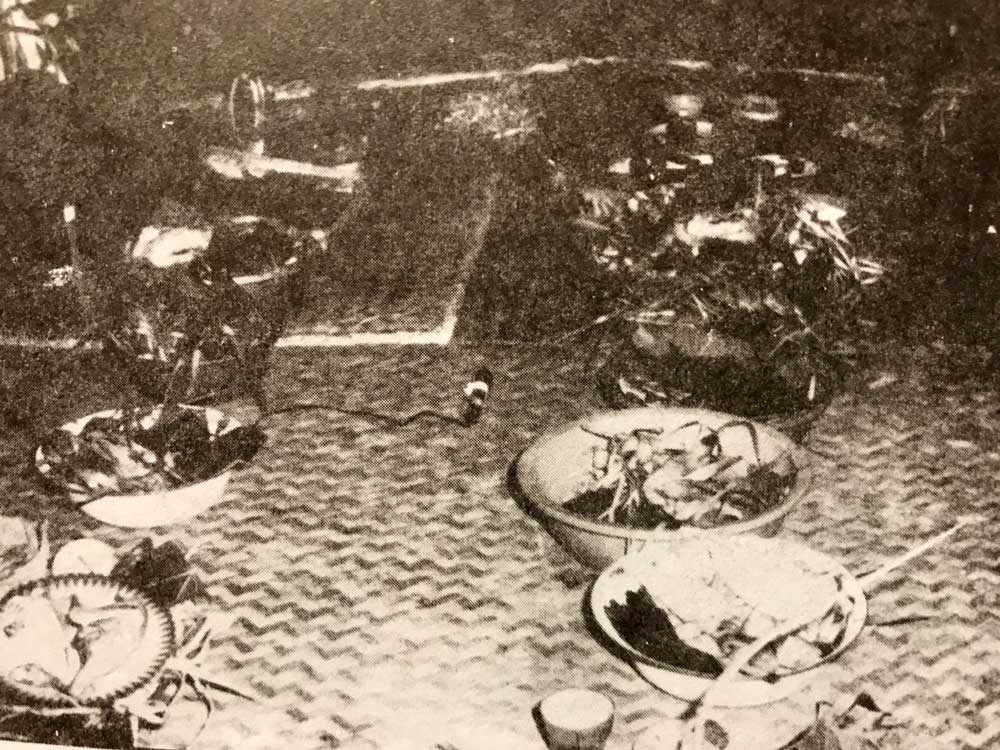The Karay-a language, or Kinaray-a, is an Austronesian regional language spoken by the Karay-a people, mainly in Antique, Iloilo and other provinces on the island of Panay, as well as portions of the Soccsksargen region in Mindanao. The contents of this article have been taken from the 1992 book THE ENDURING MA-ARAM TRADITION An Ethnography of a Kinaray-a Village in Antique by Alicia P. Magos, and may not accurately reflect all the beliefs of the modern people representing the Kinaray-a language group. Beliefs among Kinaray-a language groups can vary significantly from region to region. Since these are living beliefs, they have continued to evolve over the last thirty years.
Dr. Magos lived with and studied in the Kinaray-a community of Mariit, municipality of Dao, Antique province. Mariit is an interior upland barrio, part of the poblacion of Dao, situated in the southern part of Antique province on Panay Island. It is a settlement composed of 150 households distributed in the barrio proper and its two sitios, Mariit Takas and Bariwbariwan. Its original inhabitants came to the village about seven generations ago to start farm settlements. These people were mostly from the towns of San Joaquin, and Miag-ao of Iloilo and Dao, Antique.

SOURCE: The Enduring Ma-aram Tradition, Alicia Magos, New Day Publishers, 1992
Cosmogony
The world is generally believed to be composed of seven layers, arranged one over the other starting from the bottom layer. The first layer is the base and is not inhabited. The second layer is composed of water and is inhabited by sea-living creatures. The third layer is made of soil and is inhabited by underground spirits called idalmunon. The fourth layer, located at the center, is the middle layer of the earth’s center. It is inhabited by human beings and several kinds of engkantu living on land. The fifth layer is the atmosphere directly above us and is inhabited by supernaturals or environmental spirits who fly as a mode of travel. The sixth layer is the abode of deceased ancestors, the progenitors of the present- day ma-aram. They are joined by the angels and saints. The seventh and the last layer is the abode of the Supreme Being, the Maka-ako (Creator).
The beings inhabiting the sixth and seventh layers are referred to as the ibabawnon (“those beings above”) because they inhabit the place above man’s terrestrial plane. They are also called langitnon (“those of the heavens”) to designate their abode and their closeness to Maka-ako who stays in the high heavens. The spirit beings inhabiting the different layers of the world are described below.
The Maka-ako
As the name denotes, Maka-ako is the Supreme “Creator” and “Owner” of the universe. Since it inhabits the high heavens, not much is said about its interaction with man’s welfare and activities.
Ibabawnon
Close to God are the favored creatures, the angels and saints. The angels are winged invisible messengers, while the saints are people who lived exemplary holy lives many years ago. Villagers normally do not talk about angels and saints in their day-to-day life as the latter do not affect their daily activities. Besides, they are from other places. It is notable that it is also in this layer where the kalag, the spirits of deceased ancestors, stay.
Kahanginan
These are spirits of the air or spirits inhabiting the hangin (“air”) or the space above the earth’s surface. Only two spirit beings are recognized by the villagers in this category, the bentohangin and the hubot. The former appears like a flying horse, and the latter is a huge bird with wings that look like a huge umbrella from a distance.
Lupan-on
These are spirit beings that dwell on the land or lupa. They are the most numerous and with whom the villagers are in contact. These are known by various names: tamawo, kama-kama, muwa, burulakaw, murokpok, mangingilaw, mantiw, kapri, sigbin, bawa, mulang, and aswang sa talon.
Idalmunon
These are underground spirits. They inhabit the bowels (idalmunon comes from the root word “datum” or “deep”) of the earth’s surface. They are found when diggings or excavations are made. They are believed to be very harmful. These underground spirits include such names as the tulayhang, tibsukan and the lolid.
Tubignon
These are spirits inhabiting the bottom of the seas and oceans.
The name is derived from the word tubig or water. They have their own kingdom and they can use fishes and other sea animals as messengers for certain purposes.
Supernaturals and other spirit beings inhabiting the earth’s different layers have their own social organizations. They perform activities and have material possessions like human beings; however, normally, they are confined in their “world” or “kingdom.” Those who live near man’s environs, like the environmental spirits that inhabit the trees and forests, interact with man and have to be appeased or invited to ritual festivities if an occasion calls for it.
Creation Myth
The first portion of the story of creation as related by an old ma-aram tells of a primeval man called Tagna-an whose father is Hugna-an, a busalian. Tagna-an was the first male on earth. He had a female companion named Humihinahon. Tagna-an was born on the bubbles of the sea while Humihinahon was born between the water and the sky. It is said that each one took turns watching the other while asleep. Meanwhile, the party who was awake played with the sand and formed objects as he pleased. Out of this leisurely activity, the mountains, springs, trees, grasses, animals, and other objects came into existence. Much later, Humihinahon made a toy doll out of the sand. He gave it life and it became Adan. From the latter’s rib taken when he was asleep, Eba, his female companion came to being.
THE MA-ARAM PRACTICE IN MARIIT
The ma-aram practice is a phenomenon referred to as binabaylan by the nonpractitioners as well as those less sympathetic to the practice. In Barrio Mariit, where this phenomenon exists, practitioners prefer to be called ma-aram (literally means “knowledge”) due to the pejorative connotation attached to the term binabaylan by non-binabaylan believers. Henceforth, the vocative and referral term ma-aram will be used to refer to these village practitioners instead of baylan or babaylan and the phrase ma-aram practice to refer to the phenomenon of binabaylan.

SOURCE: The Enduring Ma-aram Tradition, Alicia Magos, New Day Publishers, 1992
Mariitnon ma-aram practice rests in a strong supernatural ideological context backed up by myths, legends and lores of great antiquity. It has a Mosaic motif, an essential ingredient in an ideology, in that it tells of a hero-liberator in the person of a busalian, Estrella Bangotbanwa, who saved the ancestors of the village from famine and hunger. Their story of creation tells of Hugna-an (father of the primeval pair), also believed to be a busalian, a person of long ago who possesses supernatural powers. It also tells of the dalongdongan, men of long ago who possess protective magical and medicinal oil making them invulnerable to danger and illness. Both busalian and dalongdongan (along with the dalagangan) are progenitors of present-day ma-aram. The aggregate source of pagkama-aram concepts, beliefs and practices, the people’s lore are found in myths, legends and other folk stories.
Central to the pagkama-aram ideology is the belief in the dungan, a soul and an ethereal body which inhabits the body and is believed to be present at the time of conception and to grow proportionately with the body. It is believed to be the essence of life and the source of animation and vitality. The dungan, however, can be lured out of the body by malevolent spirits and captured, thus resulting to lethargy and signs of illness in a person. Its prolonged absence and failure to return to the body causes illness and eventual death. As such, it has to be coaxed back to the body for any harm that may befall the soul outside the body will have its corresponding effect on the physical body of the person. It is here where the special role and expertise of the ma-aram comes in for the ma-aram has a divine “calling” and a special training that qualifies him to communicate with the spirits and supernaturals. While this mediation can take place privately with the ma-aram, communication with the spirits is usually performed in public for rituals are curative in nature and are intended to embolden, nurture, and lengthen the life of the soul.
Now the question can well be asked, “what makes the ma-aram supernatural ideology enduring in the community?” A careful look at the contents of ma-aram lores, ideas and beliefs would note that these contain the villagers’ basic quest about the universe—its origin, structure, its first people and their habitation. They tell, describe and explain the source of life and vitality as shown in the relationship of the concept of dungan with health, illness and death. They tell about supernatural forces in the form of ancestral and environmental spirits, their relationship with the living and how they could be communicated with through the ma-aram. These are all questions that man inevitably asks and attempts to understand in relation to his existence and that of his environment. Here, Mariitnon supernatural ideology which is overwhelmingly ma-aram-oriented, gives the answer.
Closely interwoven with ideology is the people’s medical system. Medicine as used here refers to the “art of healing” or “the science of the preservation of health and of treating disease for the purpose of cure.” It could be viewed as the people’s expression of ideas and beliefs found mostly in their supernatural ideology. As previously mentioned, ideology affects the people’s way of doing things and behavior according to certain situations. It shows their attitudes and valuation of actuations. It is in the people’s medical system where cognition is operationalized.

SOURCE: The Enduring Ma-aram Tradition, Alicia Magos, New Day Publishers, 1992
Concept of Dungan (Soul)
The Kinabisya (meaning “of the Bisayan,” or “belonging to the Bisayans”) religious belief system is based on ma-aram beliefs and practices which the ma-aram of today help preserve by keeping the tradition alive in the lore of the villagers. This belief system informs the worldview of the people in many places in the Visayas either exceedingly or minimally depending upon the encroachments or the inroads of modernization or westernization in a given area. In the poblaciones and in other acculturated towns and villages, the encounter of traditional animistic religion with that of Roman Catholicism and other forms of the Christian religion has created a syncretic type of religious belief system. But such is not always the case. In many places much of the traditional animistic religion has been preserved as in the case of Mariit. This animistic belief system includes the Mariitnon concept of the soul, mythology, cosmogony, concepts of a hierarchy of existing spirits, sacred places and rites.
The idea of a dungan is central to the ma-aram “calling” and activities. It is a key concept to the understanding of illness and the well-being of a villager. Because of the presence of a dungan in the body which needs to be nurtured, strengthened and protected from environmental spirits, healing and ritual activities are performed by the ma-aram. The dungan of a living person can leave the body and be coaxed to return. By itself, if strong due to ritual nurturing, it is capable of causing illness or to seriously weaken other persons who have weaker dungan. If weak, the dungan has to be strengthened in a religio-magical rite to prevent or cure body illness caused by its inherent weakness.

SOURCE: The Enduring Ma-aram Tradition, Alicia Magos, New Day Publishers, 1992
The Engkantu: Spirit Beings in the Village
In Mariit, the engkantu that the villagers are more familiar with are the lupan-on because these are the spirit beings that inhabit their immediate surroundings. The more commonly talked about are the tamawo, murokpok, kama-kama, bawa, burulakaw, and the kapri. There are also stories or reports of mangingilaw, sigbin, the lolid, tulayhang and the muwa. The tibsukan and the tulayhang, though inhabiting the sub-surface of the ground, are believed to come in contact with humans when a place for a house to be constructed is dwelt by them and no rite is performed to appease them or drive them out. The bentohangin and the hubot are also mentioned though experiences with them are rare.
Tamawo
The tamawo are described as “beautiful or handsome and fair- complexioned.” When wanting to court a villager, a tamawo appears as an ordinary person but when scrutinized closely, he is said to have no narrow groove on the upper part of the lip. One’s image is also believed to appear slanted when seen through the pupil of the tamawo’s eye. A person courted by a tamawo exhibits strange (lunatic-like) behavior. The tamawo that reside in Mariit are known by the following names:
- Bumalabag, also a male engkantu whose job is to drive away spirit beings who bring illness to people and animals.
- Liktin-laktud, another male engkantu, who views and visits places. He walks fast and crosses hills.
- Manupongtupong, a male engkantu who dresses just like an ordinary man. He is a big man, fond of roaming around but he usually stays close to the hills.
- Manla-aw-la-aw, a male engkantu who also roams around and looks out from behind a hill.
- Manilagnilag, a female engkantu who likes to be present in all social gatherings and festivities. She attends ritual gatherings.
- Mambukay or Kalambukay, another female engkantu who dwells near the shallow wells. She is the object of ritual offerings by ma-aram every year.
Murokpok
While the tamawo are not known to be malevolent, the murokpok are noted to be harmful. They are relatively small, dark- complexioned and curly-haired. They look somewhat cross-eyed. When they roam around in the farm or hills, they wear a red bandana on their head. They usually bring with them a bow and arrow which they use to inflict harm on any person they meet. If a cane is aimed at a person, this person falls unconscious and gets ill. If the person is hit by a murokpok, he would die.
Kama-kama
The kama-kama are known to be both helpful and naughty. They are very small, from one to two feet in height. When kind, they can bring luck to a family by giving or showing them treasures or magical objects that will bring them luck. When naughty, they could pinch and this is known only by the appearance of some bluish-blackish spots on the skin. They are known also to put foreign objects like small stones, broken glasses, or hair on a person’s body especially when one takes a bath near a shallow well.
Bawa
The bawa are supernatural entities with wide dangling lips enough to cover their face. They can take the form of a chicken and make their presence known by a cackling sound. They can also transform themselves into a cow, a pig, a stone, or a dog. The bawa are believed to be harmless if left to themselves. Once they are harmed, however, they could be very cruel because they could wring the neck of a carabao or that of a man.
Burulakaw
The burulakaw appear like balls of fire with tails when viewed at a distance. Actually they are small women with long hair appearing like strands of fire covering their bodies. They resemble shooting stars except that they travel horizontally in the air in a sloping manner starting from a point of origin which is usually a stream or shallow well. Once they reach a destination, they disappear. They travel day and night, but they could only be seen in the evening when there is no more glare from the sun. Because they travel fast, they are believed to be the messengers of supernaturals in the higher order.
Kapri
The kapri are big supernatural beings inhabiting huge trees. They usually visit abandoned buildings. During the night they appear as big people smoking huge pipes and standing near big trees. They are seldom violent and are aggressive only when challenged. When angry, they are known to pick up people and throw them up like playthings.
Muwa
The muwa are also supernatural beings that appear as old men and women. They stay in old abandoned houses and are known to hoard food provisions like palay. If a farmer fails to invite them at the pangkuyang, a pre-harvest rite, they are known to harvest the palay ahead of the farmers and store the crop for their own use.
Mangingilaw
The mangingilaw are bigger than ordinary persons and have hairy bodies, big teeth and long hair. A mangingilaw can devour a man alive. They do not wear any clothing, though some informants say that they wear a tampi, a small piece of clothing to cover their lower private parts.
Sigbin
The sigbin look like ordinary people, except that they live in the forest or in wooded areas of villages. They usually roam around at twelve noon in search for victims. Some people say the sigbin are maranhig, who run astray and have gone to the forest to live.
Lolid
The lolid live under the ground. They look like newborn puppies or piglets. White in color, they have very short legs, sometimes even reported as having no legs at all. They move about by rolling. Once unearthed under the ground, where a house is to be constructed, they may cause illness to a member of the household. They are pets of the engkantu.
Tibsukan
The tibsukan look like small pigs with long snouts. Like the lolid they are also pets of the engkantu. Once commanded by their master, they can bore holes from underneath the house causing illness to a member of the household. A house should not be constructed in a place where there are tibsukan.
Tulayhang
The tulayhang like the lolid and tibsukan, are also pets of the engkantu that live underneath the ground at the mouth of the river where it bores a hole. Their form resembles that of an umang- umang, a small crab-like animal that inhabits empty seashells. Once unearthed under the ground where a house is to be constructed, it, too, can cause illness.
Hubot and Bentohangin
The hubot and the bentohangin are engkantus which inhabit the air above the ground. Encounters with them are rare. The hubot resemble a huge umbrella in the air approaching from a distance but they are actually huge birds with wide wings. The bentohangin resemble that of a flying horse, but half of their body is that of a man. They neigh like a horse and are known to roam the village past midnight.
Kapapu-an (Ancestral Soul-Spirits)
The villagers also pay their respects and show love to another group of unseen spirit beings, their kapapu-an. Unlike some engkantu, their papu are not malevolent because of their kin affiliation with them. More familiar to many villagers and remembered in their lores are deceased ma-aram ancestors who died long ago and were noted for their supernatural feats. These are the busalian, dalagangan, and the dalongdongan. The busalian are known for their ability to produce water from a rock by merely thrusting the spear to a rock. Once the rock is struck, water gushes out for thirsty people to drink. The dalagangan are known for their ability to make tremendously high leaps and jumps. A dalagangan can cross a hill with one leap. The dalongdongan are known for their ability to protect themselves from harm or danger, by rubbing their bodies with magical medicinal oil called dalungdong.
Ma-aram in the village trace their consanguineal affinity to a deceased ma-aram in their lineage who possessed busalian powers, or a combination of two or three skills from either side of the family line. It is from the busalian ancestors that the ma-aram of Mariit and neighboring towns and barrios inherited their skill and “calling.” Some ma-aram also mentioned other ma-aram feats like having tigadlum (rendering oneself invisible) powers or tigalpu (ability to pass through a solid wall) but these are from ma-aram of other family lines from other villages and places. Asked why the ma-aram of today no longer possess the supernatural skills of their progenitors (busalian, dalagangan, and dalongdongan), some ma-aram say that these powers must have been taken away because either those gifted earlier abused them or perhaps they were taken away to prevent the abuse of the skills.
The kapapu-an who are in the “other world,” whether they are ma-aram or not, have always communicated their desires to the living kin to follow certain obligatory rites, like those held in connection with life-cycle, farming, house-building, death rites, and “callings” to become a ma-aram. Since most deceased people are old, they are conservative and would want tradition in a genealogical line to be followed.
SOURCE: The Enduring Ma-aram Tradition: An Ethnography of a Kinaray-a Village in Antique, Alicia Magos, New Day Publishers, 1992
Jordan Clark is a Canadian born descendant of Scottish immigrants living on the homelands of the Lekwungen speaking peoples. His interest in Philippine myth and folklore began in 2004. Finding it difficult to track down resources on the topic, he founded The Aswang Project in 2006. Shortly after, he embarked on a 5 year journey, along with producing partner Cheryl Anne del Rosario, to make the 2011 feature length documentary THE ASWANG PHENOMENON – an exploration of the aswang myth and its effects on Philippine society. In 2015 he directed “The Creatures of Philippine Mythology” web-series, which features 3 folkloric beings from the Philippines – the TIKBALANG, KAPRE and BAKUNAWA. Episodes are available to watch on YouTube. Jordan recently oversaw the editing for the English language release of Ferdinand Blumentritt’s DICCIONARIO MITOLÓGICO DE FILIPINAS (Dictionary of Philippine Mythology) and is working on two more releases with fellow creators scheduled for release later this year. When his nose isn’t in a book, he spends time with his amazing Filipina wife of 20 years and their smart and wonderful teenaged daughter.


